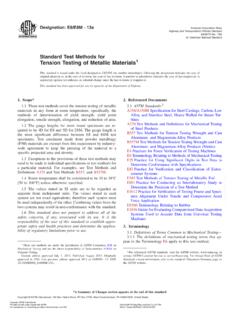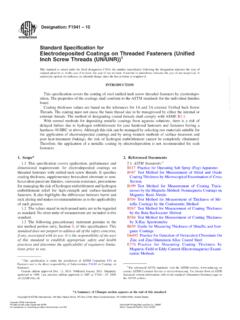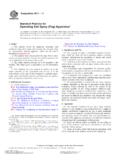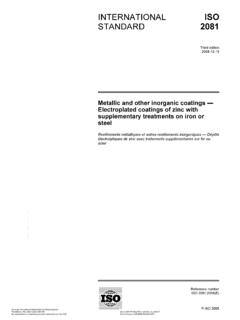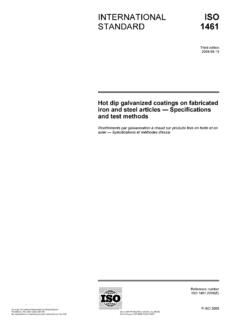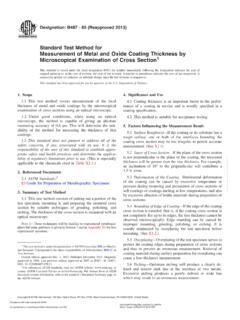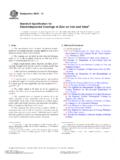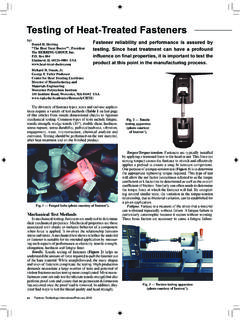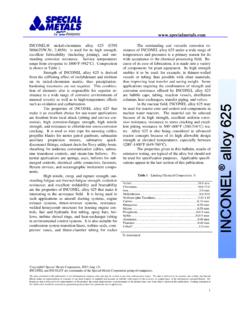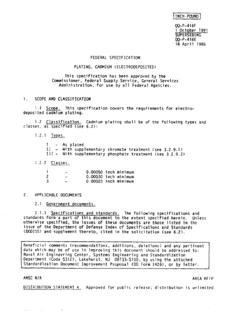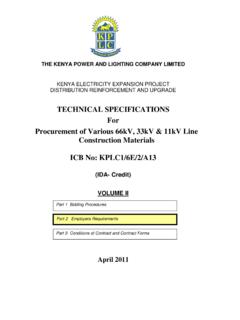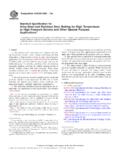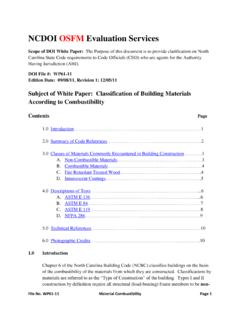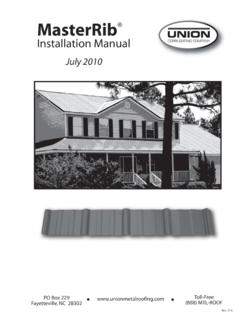Transcription of Designation: B633 13 - American Tinning & Galvanizing
1 Designation: b633 13 Standard Specification forElectrodeposited Coatings of Zinc on Iron and Steel1 This standard is issued under the fixed designation b633 ; the number immediately following the designation indicates the year oforiginal adoption or, in the case of revision, the year of last revision. A number in parentheses indicates the year of last reapproval. Asuperscript epsilon ( ) indicates an editorial change since the last revision or standard has been approved for use by agencies of the Department of This specification covers material and process require-ments for electrodeposited zinc coatings applied to iron or steelarticles to protect them from The coatings are provided in four standard thicknessclasses ( ), in the as-plated condition or with one of fivetypes of supplementary finishes ( ). High strength metals, unless otherwise specified, includ-ing high strength steels having a tensile strength greater than1700 MPa (247 ksi, 46 HRC) shall not be It does not cover continuous processes for electrodepos-ited zinc coated steel wire or sheets (see SpecificationA591/A591 Mfor sheets.)
2 It may be used for fasteners but specific specificationshave been developed for manufacturing fasteners in CommitteeF16 which may be more applicable (see The values stated in SI units are to be regarded asstandard. No other units of measurement are included in standard does not purport to address all of thesafety concerns, if any, associated with its use. It is theresponsibility of the user of this standard to establish appro-priate safety and health practices and determine the applica-bility of regulatory limitations prior to standard has been revised to address RoHS re-quirements that seek to limit the exposure of workers and thepublic from exposure to toxic metals. Additional types V and VIhave been added to permit non-chromate passivate treatmentsto be used in replacement of hexavalent Referenced Standards:2A591/A591 MSpecification for Steel Sheet, ElectrolyticZinc-Coated, for Light Coating Weight [Mass] Applica-tions(Withdrawn 2005)3B117 Practice for Operating Salt Spray (Fog) ApparatusB183 Practice for Preparation of Low-Carbon Steel forElectroplatingB201 Practice for Testing Chromate Coatings on Zinc andCadmium SurfacesB242 Guide for Preparation of High-Carbon Steel for Elec-troplatingB254 Practice for Preparation of and Electroplating onStainless SteelB320 Practice for Preparation of Iron Castings for Electro-platingB322 Guide for Cleaning Metals Prior to ElectroplatingB374 Terminology Relating to ElectroplatingB487 Test Method for Measurement of Metal and OxideCoating Thickness by Microscopical Examination ofCross SectionB499 Test Method for Measurement of Coating Thicknessesby the Magnetic Method.)
3 Nonmagnetic Coatings onMagnetic Basis MetalsB504 Test Method for Measurement of Thickness of Metal-lic Coatings by the Coulometric MethodB567 Test Method for Measurement of Coating Thicknessby the Beta Backscatter MethodB568 Test Method for Measurement of Coating Thicknessby X-Ray SpectrometryB571 Practice for Qualitative Adhesion Testing of MetallicCoatings1 This specification is under the jurisdiction of ASTM CommitteeB08onMetallic and Inorganic Coatings and is the direct responsibility of Soft edition approved May 15, 2013. Published June 2013. Originallyapproved in 1978. Last previous edition approved in 2011 as b633 11. referenced ASTM standards, visit the ASTM website, , orcontact ASTM Customer Service at ForAnnual Book of ASTMS tandardsvolume information, refer to the standard s Document Summary page onthe ASTM last approved version of this historical standard is referenced ASTM International, 100 Barr Harbor Drive, PO Box C700, West Conshohocken, PA 19428-2959.
4 United States1 Copyright ASTM International Provided by IHS under license with ASTM Sold to:NW PA Reg Plann and Dev Co, 803404 Not for Resale,07/08/2013 12:40:35 MDTNo reproduction or networking permitted without license from IHS--`,,`,,,,``````,`,`,`,,`````,`-`-`,, `,,`,`,,`---B602 Test Method for Attribute Sampling of Metallic andInorganic CoatingsB697 Guide for Selection of Sampling Plans for Inspectionof Electrodeposited Metallic and Inorganic CoatingsB762 Test Method of Variables Sampling of Metallic andInorganic CoatingsB849 Specification for Pre-Treatments of Iron or Steel forReducing Risk of Hydrogen EmbrittlementB850 Guide for Post-Coating Treatments of Steel for Reduc-ing the Risk of Hydrogen EmbrittlementD2092 Guide for Preparation of Zinc-Coated (Galvanized)Steel Surfaces for Painting(Withdrawn 2008)3F1470 Practice for Fastener Sampling for Specified Me-chanical Properties and Performance InspectionF1941 Specification for Electrodeposited Coatings onThreaded Fasteners (Unified Inch Screw Threads (UN/UNR))
5 F1941 MSpecification for Electrodeposited Coatings onThreaded Fasteners (Metric) Standard:4 MIL-STD-1312 Fastener Tests, Methods (Test 12)3. Definitions of the terms used in this specification arein accordance with for the purpose of this specification, aconversion coating on zinc shall not contain hexavalent The coating shall be provided in one of thefour thickness classes defined inTable The coating shall have one of the finish typesdefined inTable Ordering When ordering the electroplating of articles, the pur-chaser shall state ASTM b633 , the date of issue, servicecondition number, and the Type ( , , ). If necessary, the purchaser shall include on his partdrawings or purchase order the Basis metal alloy designation and ultimate tensilestrength of the steel, Thickness, if other than specified ( , ), Location of significant surface ( , ), Luster ( ), Exceptions to stress relief heat treatment prior toplating, ( ), Exception to Hydrogen Embrittlement Relief afterplating, ( ).
6 Corrosion resistance test, if specified ( , ), Hydrogen embrittlement test, if required ( , ),including the tensile strength of the items, Sample size for inspection, if other than specified, Supplementary requirements, if applicable (seeSupplementary Requirement).6. Materials and The coatings shall be non-alloyed zinc produced Defects in the surface of the basis metal, such asscratches, porosity, pits, inclusions, cracks, roll marks, and diemarks, may adversely affect the appearance and performanceof coatings applied thereto despite the observance of the bestelectroplating practices. Accordingly, the electroplater s re-sponsibility for defects in the coating resulting from suchconditions shall be waived, except when he is the primecontractor supplying electroplated parts. In this event, the basismetal shall be subjected to such polishing or buffing operationsas are necessary to yield deposits with the desired final lusterand appearance.
7 To minimize problems of this sort, thespecifications covering the basis material on the item to beelectroplated shall contain appropriate limitations to such basismetal of Basis Metal Proper preparatory proce-dures and thorough cleaning of the basis metal are essential toensure satisfactory adhesion and corrosion resistance perfor-mance of the coating. It is recommended that the followingappropriate recommended practices and guides be used:B183,B242,B254,B320, of Iron or Steel for the Purpose of Reduc-ing the Risk of Hydrogen Embrittlement All steel parts havingan ultimate tensile strength greater than 1000 MPa (31 HRC)and that have been machined, ground, cold formed, or coldstraightened, shall be heat treated for stress relief to reduce therisk of hydrogen embrittlement in the part before clean andelectroplate processes. If these heat treatments are not required,the purchaser shall specify in the ordering information their4 Available from Standardization Documents Order Desk, DODSSP, Bldg.
8 4,Section D, 700 Robbins Ave., Philadelphia, PA 19111-5098, 1 Thickness Classes for CoatingsClassification Numberand ConversionCoating SuffixService ConditionThickness, min mFe/Zn 25SC 4 (very severe)25Fe/Zn 12SC 3 (severe)12Fe/Zn 8SC 2 (moderate)8Fe/Zn 5SC 1 (mild)5 TABLE 2 Finish Type and Corrosion Resistance RequirementsTypeDescriptionMinimum Salt SprayhIAs-plated without supplementarytreatmentsIIWith colored chromate coatings96 IIIWith colorless chromateconversion coatings12 IVWith phosphate conversioncoatingsVWith colorless passivate72 VIWith colored passivate120B633 132 Copyright ASTM International Provided by IHS under license with ASTM Sold to:NW PA Reg Plann and Dev Co, 803404 Not for Resale,07/08/2013 12:40:35 MDTNo reproduction or networking permitted without license from IHS--`,,`,,,,``````,`,`,`,,`````,`-`-`,, `,,`,`,,`---exception, ( ). If the purchaser does not specify an excep-tion to heat treatment, then the plater shall use Table 1 inB849to determine the appropriate heat treatment for the steel basedon its tensile Coating Treatments of Iron and Steel for thePurpose of Reducing the Risk of Hydrogen Embrittlement Allelectroplated steel parts having a tensile strength greater than1000 MPa (31 HRC) as well as surface hardened parts, shall bebaked to reduce the risk of hydrogen embrittlement.
9 If theseheat treatments are not required, the purchaser shall specify inthe ordering information their exception ( ). If the pur-chaser does not specify an exception to heat treatment, then theplater shall use Table 1 inB850to determine the appropriateheat treatment for the steel based on its tensile strength. Thebaking treatment shall be done before the application of thesupplementary treatments and within4hofremoval from thelast process. Electroplated springs and other parts subject toflexure shall not be flexed before the hydrogen embrittlementrelief treatment. Baked parts shall not crack or fail by fracturewhen tested in accordance Treatment Electroplated surfaces passi-vated as a result of the baking operation shall be reactivatedbefore receiving a supplementary Surfaces should be activated as soon as possible followingbaking and handled carefully to avoid contamination and maintain anactive surface for post processing.
10 Proprietary methods are available toprepare the surface or a 2% v/v sulfuric acid in deionized water or a 7-10g/L solution of sulfamic acid in deionized water can be Treatments The supplementary filmtreatment for Types II, III, V, and VI shall be in accordancewith PracticeB201(seeNotes 2 and 3). The treatment requiredfor conversion to Type IV shall be in accordance with The zinc surface is attacked by supplementary treatments,thereby diminishing the amount of metallic zinc present. With ClassesFe/Zn25 and Fe/Zn12, this reduction is insignificant; but it is significantwith Fe/Zn8 and Fe/Zn5. Therefore, it is recommended that supplemen-tary treatments not be applied to zinc coatings having a nominal thicknessless than 5 Although Types V and VI are technically not chromate filmsand they do not contain leachable hexavalent chromium ions, they aresupplemental coatings that render the active zinc surface passive andprovide added protection to the steel Coating The thickness shall be specified in accor-dance (seeNote 2).
